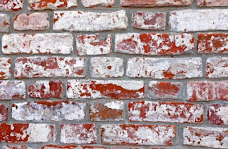Constituents of good and Harmful Ingredients in Brick
BRICK
 |
| Efflorescence in BrickStone in Brick |
Constituents
of good brick earth:
Bricks are the most commonly used construction material.
Bricks are prepared by moulding clay in rectangular blocks of uniform size and
then drying and burning these blocks. In order to get a good quality brick, the
brick earth should contain the following constituents.
- Silica
- Alumina
- Lime
- Iron oxide
- Magnesia
Silica
o Brick earth should contain about 50 to % of silica.
o It is responsible for preventing cracking,
shrinking and warping of raw bricks.
o
It also affects the durability of bricks.
o If present in excess, then it destroys the cohesion between particles and the brick becomes brittle.
Alumina
o
Good brick earth should contain about 20% to 30%
of alumina.
o
It is responsible for plasticity characteristic
of earth, which is important in moulding operation.
o If present in excess, then the raw brick shrink and warp during drying.
Lime
o
The percentage of lime should be in the range of
5% to 10% in a good brick earth.
o
It prevents shrinkage of bricks on drying.
o It causes silica in clay to melt on burning and thus helps to bind it.
o Excess of lime causes the brick to melt and brick looses its shape.
Iron oxide
o
A good brick earth should contain about 5% to 7%
of iron oxide.
o
It gives red colour to the bricks.
o It improves impermeability and durability.
o It gives strength and hardness.
o If present in excess, then the colour of brick becomes dark blue or blakish.
o
If the quantity of iron oxide is comparatively
less, the brick becomes yellowish in colour.
Magnesia
o Good brick earth should contain less a small quantity of magnesia about1%)
o Magnesium in brick earth imparts yellow tint to the brick.
o It is responsible for reducing shrinkage
o Excess of magnesia leads to the decay of bricks.
Harmful Ingredients in Brick:
Below mentioned are some of the ingredients which are undesired in brick earth.
Lime
o
A small quantity of lime is required in brick
earth. But if present in excess, it causes the brick to melt and hence brick
looses its shape.
o If lime is present in the form of lumps, then it is converted into quick lime after burning. This quick lime slakes and expands in presence of moisture, causing splitting of bricks into pieces.
Iron
pyrites
o
The presence of iron pyrites in brick earth causes
the brick to get crystallized and disintegrated during burning, because of the
oxidation of the iron pyrits.
o Pyrites discolourise the bricks.
Alkalis
o
These are exist in the brick earth in the form
of soda and potash. It acts as a flux in the kiln during burning and it causes
bricks to fuse, twist and warp. Because of this, bricks are melted and they
loose their shape.
o The alkalis remaining in bricks will absorb moisture from the atmosphere, when bricks are used in masonry. With the passage of time, the moisture gets evaporated leaving grey or white deposits on the wall surface (known asefflorescence). This white patch affects the appearance of the building structure.
Pebbles
o
Pebbles in brick earth create problem during
mixing operation of earth. It prevents uniform and through mixing of clay,
which results in weak and porous bricks
o
Bricks containing pebbles will not break into
shapes as per requirements.
Vegetation and Organic Matter
o The presence of vegetation and
organic matter in brick earth assists in burning. But if such matter is not
completely burnt, the bricks become porous. This is due to the fact that the
gasses will be evolved during the burning of the carbonaceous matter and it
will result in the formation of small pores.
Read more:
Classification of Bricks as per common practice and as per constituent materials
Hand moulding,ground moulding and machine moulding of bricks
All Types of Lab Tests on Bricks for Building Construction Works






No comments:
Post a Comment
If you are getting more information from civilengineerfriend page please give your comments. Share the page information in your whatsapp group. Subscribe our page to get more information.